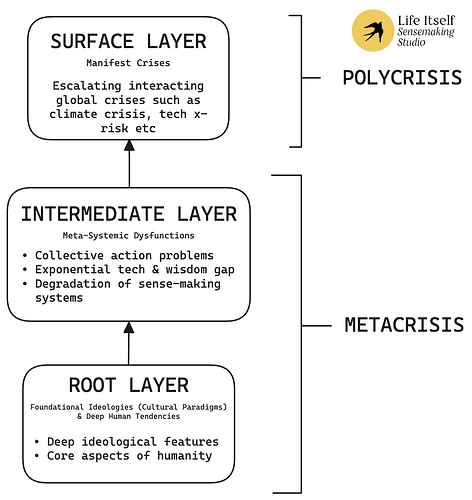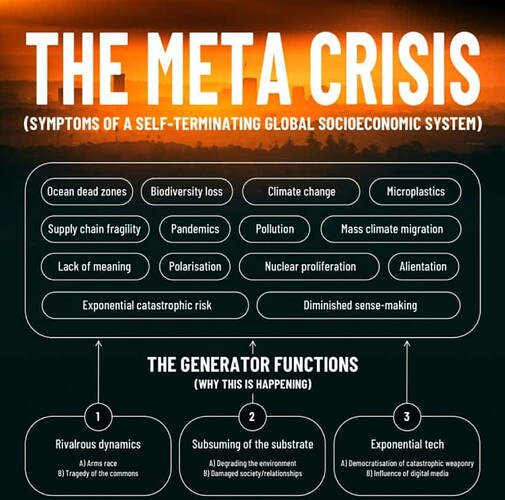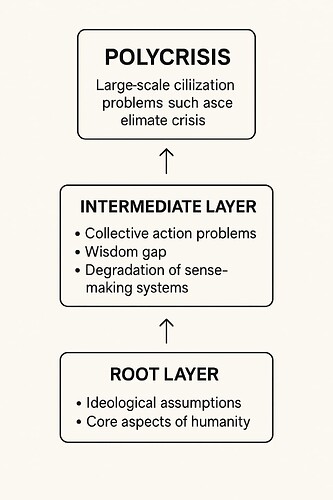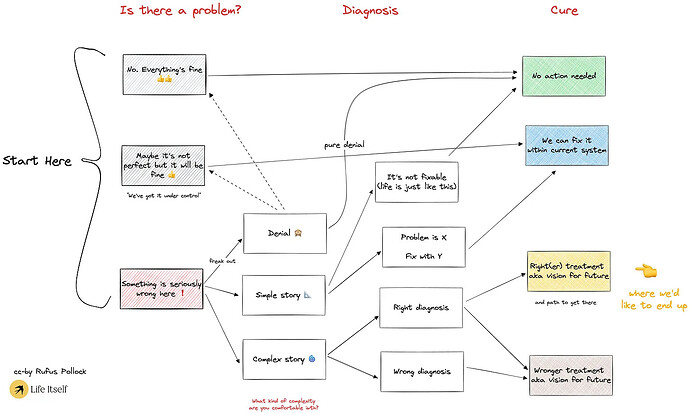Having tried the “lite” approach and the “mid-range” approach to introducing the metacrisis crisis idea, here is another model to look at. I’m calling this one the “short-synthesis”.
The metacrisis can be understood as an existential threat to humanity itself. Unlike some external threat - like the asteroid that killed the dinosaurs - the metacrisis results from humanity’s recently acquired ability to kill off itself. The metacrisis thus presents fundamental questions about the meaning of human life and purpose of human existence on this planet.
On a systems level, the most proximate cause of the metacrisis is exponential human population growth on a finite planet. This population growth was fueled by similarly exponential trends in technical innovation and energy consumption. On principle, technical innovation could continue farther than current eyes might see, but energy consumption is another matter. Fossil fuels are a one-time resource pool. Likewise, there are no vast reserves of planetary forests, farm land, fish, high quality mineral deposits, and pristine biomes left untapped. Although prior Maltusian predictions of population limits (most famously that of Malthus himself) failed to materialize on predicted schedule, the overall impression of the competing exponential growth curves is that industrial exploitation of fossil energy pushed population boundaries wider, but did not abolish such boundaries in any fundamental way. A first take on the metacrisis might be, how do we adjust to a world in which human increase does not justify itself?
Beyond population biology and environmental impacts, impending limits to growth are sure to roil any number of social systems predicated on ever increasing material expansion. Economic theorist Peter Pogany discusses global populuation plus its economy (GLOPPE) and notes there are thermodynamic limits to any such arrangement. As one world system after another runs into its thermodynamic barriers, each system breaks down in a “chaotic transition”. In line with general evolutionary theory, the chaotic components cut loose in each transition reassemble into a new higher-complexity world system eventually. But overall the process is entropy-producing and forces each successor system to become less crudely extractive than the prior.
We currently seem very much in the latest chaotic transition, the interlude between US-led post-WWII world order and no evident order at all. The upshot is likely to be economic and political dislocations at local to global scales landing differently in different places. Because of the larger metacrisis framing around GLOPPE and its entropic limits, it’s doubtful ad hoc adjustment to this or that political or economic subsystem will have much definitive effect. But prior chaotic transitions experimented with various retrograde and extreme models before arriving at the most efficient available global structures. Much destruction attended this experimentation. Ideally, we can escape mass destruction this time, but such views exist more in hope than in probability.
Part of what defines a world system is the common sense or mindset that defines best practices under that system. Growth-oriented economics and political expansion fueled by such economics have been common-sensical from the dawn of civilization, if not prior. In a variety of continenal geographies, limits to growth have been hit, collapse has resulted, and the territory was eventually recolonized through different civilizations or through civilizational revivals. Our current experiment in limits to growth occurs uniquely on a planetary scale. In previous civilizations, it was possible to imagine available resource frontiers or cost-free sinks for waste products. It was likewise possible to imagine external populations available for conquest and subjugation. Now, however, that prior “common sense” about expansionary politics and economics fails to make sense at all. That cognitive clash between what we assumed must be true and very likely cannot continue to be true leads to cultural dislocation, lately called the meaning crisis.
Pogany found a way forward in meaning from the current chaotic transition in the work of Jean Gebser on structures of consciousness. Pogany imagined Gebser’s integral consciousness might point the way forward to the next world system beyond current chaos. One might imagine a variety of new or revitalized wisdom traditions that fulfill the qualities of Gebser’s integral consciouness. The point here is not to spell out the details of what emerging consciouness needs to be. All we need do here is to point out that pure empiricism and logical analysis - hallmarks of Western “common sense” up until now - point beyond themselves to the need for something more in future cycles. I leave it to the reader’s imagination what that “more” might look like.



